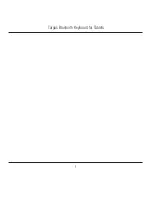
User Guide
29
ProFire 2626
Sample Rate
This menu selects the sample rate of the
interface when operating in Standalone Mode
Optical Port B Mode
This parameter determines how the second pair
of optical ports will operate when the interface is
in Standalone mode
ADAT:
Selecting “ADAT” will allow you to send and
receive four channels of audio at 88 2/96 kHz
(per ADAT port; S/MUX II) or two channels
at 176 4/192 kHz (per ADAT port; S/MUX
IV) In Standalone Mode, Optical Port B can
only be set to ADAT when the interface is
operating at sample rates of 88 2 to 192 kHz *
S/PDIF:
Selecting “S/PDIF” allows the second optical
input and output ports to convert optical
S/PDIF signals into coaxial S/PDIF signals
while simultaneously converting coaxial
S/PDIF to optical S/PDIF
* Since ProFire 2626 has a maximum of
eight analog inputs and outputs, optical
port B is not necessary for A/D or D/A
conversions at 44.1/48 kHz. Optical port
B can be used for A/D, D/A operation at
sample rates above 48 kHz.
NOTE
: This parameter only displays sample
rates (i.e., “44.1 kHz”, “48 kHz”, etc.) when the
Standalone Mode Sync Source is set to “Internal.”
If you are clocking the interface to an external S/
PDIF or Word Clock device, this parameter displays
“Auto” and the interface automatically locks to
the sample rate of the master device. If you are
clocking to an ADAT device, this menu provides
the same options found under the S/MUX Mode
parameter while in hosted mode (“Auto,”
“S/MUX II (88.2 to 96 kHz),” and “S/MUX IV
(176.4 to 192 kHz).” See the S/MUX Mode
description earlier in this section to learn more
about these settings.
Note
: The coaxial and optical S/PDIF ports support
a maximum sample rate of 96 kHz when operating
in Standalone mode. This is because optical S/
PDIF has a maximum sample rate limit of 96
kHz. As a result, when ProFire 2626 is operating
at sample rates above 96 kHz, this parameter
automatically defaults to ADAT mode.
Summary of Contents for PROFIRE 2626
Page 1: ...User Guide...
















































